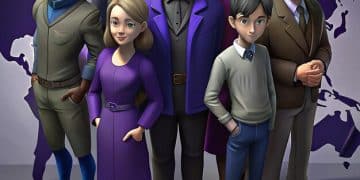Exploring the Enduring Appeal of Animated Series

Animated series continue to captivate audiences of all ages, offering a unique blend of storytelling, visual artistry, and thematic exploration that resonates across cultures and generations.
From heartwarming tales to thrilling adventures, animated series have cemented their place in popular culture. Let’s delve into why animated series remain a beloved form of entertainment for millions.
The Evolution of Animated Series
The landscape of animated series is constantly evolving, reflecting changes in technology, storytelling trends, and audience expectations.
To understand the current appeal of animated series, it’s crucial to recognize the historical milestones and shifts that have shaped the industry. This journey begins with the early pioneers of animation and extends to the modern era of streaming platforms and diverse content creation.
Early Beginnings and Classic Animation
The roots of animated series can be traced back to the early 20th century, with pioneers like Winsor McCay and Walt Disney laying the groundwork. These early animations were often short, simple, and primarily aimed at children. Disney’s creations, such as Mickey Mouse and Donald Duck, quickly became household names, setting a high standard for character animation and storytelling.
Here are some key milestones from the early days of animation:
- 1908: Émile Cohl releases “Fantasmagorie,” one of the earliest examples of traditional (hand-drawn) animation.
- 1928: Steamboat Willie, starring Mickey Mouse, is released and marks the beginning of Disney’s dominance in animation.
- 1930s: The Golden Age of Animation sees the rise of iconic characters and studios, including Warner Bros. with Looney Tunes and Merrie Melodies.
- 1960s: Hanna-Barbera introduces limited animation techniques to create series like The Flintstones and The Jetsons, making animation production more efficient for television.
The shift from theatrical shorts to television series allowed for longer narratives and character development, which brought up a wider audience. However, these early series often faced limitations in terms of budget and production quality, leading to the utilization of limited animation techniques of Hanna-Barbera. Despite these limitations, these series established animation as a staple of television programming.
Modern Animation and Technological Advancements
The late 20th and early 21st centuries witnessed a renaissance in animated series, driven by technological advancements and a desire for more mature and sophisticated storytelling. Computer-generated animation (CGI) and advancements in digital tools have revolutionized production, allowing for the creation of visually stunning and complex series.

The use of CGI has allowed animators to create immersive worlds and characters with unprecedented detail, while digital compositing and editing have streamlined the production process.
Influence of anime on Western Animation
Anime has influenced Western animation series through its unique visual style, storytelling techniques, and range of genres.
- Visual Style: Many Western animated series have adopted visual elements from anime, such as large, expressive eyes, detailed hair, and dynamic action sequences.
- Storytelling: Anime is known for its complex narratives, character-driven plots, and exploration of mature themes.
- Genre Diversity: Anime covers a wide range of genres, including science fiction, fantasy, romance, horror, and slice-of-life stories. This diversity has inspired Western animators to explore new genres and themes in their own series.
Popular anime series, such as “Dragon Ball Z”, has inspired countless Western animators and creators.
Genres and Target Audiences
Animated series cater to a broad spectrum of audiences, spanning from preschoolers to adults, with various genres to accommodate diverse interests.
The diversity in genres and target audiences has transformed the animated series landscape, making animation a versatile and respected form of entertainment for individuals of all age groups.
Children’s Animation
Designed primarily for young children, these series typically focus on educational content, positive social messages, and simple, engaging narratives. Notable examples include:
- Sesame Street: Focuses on early childhood education with a mix of live-action and animated segments.
- Blue’s Clues: An interactive show that encourages problem-solving skills.
- Peppa Pig: A slice-of-life series that follows the everyday adventures of a charming pig family.
Teen Animation
Aimed at teenagers, these series often deal with more complex themes such as identity, relationships, and social issues. They can range from light-hearted comedies to more serious dramas:
- The Owl House: A fantasy series that tackles themes of identity, acceptance, and found family.
- She-Ra and the Princesses of Power: A reboot of the classic 1980s series, it addresses friendship, leadership, and the fight against oppression.
Adult Animation
Targeting adult audiences, these series often explore mature themes, satire, and dark humor. Adult animation has gained significant popularity, breaking barriers and challenging conventions with each new series.
- Rick and Morty: A science fiction comedy known for its dark humor, nihilistic themes, and complex characters.
- Bojack Horseman: Explores themes of depression, addiction, and the struggles of fame in a poignant manner.
The key takeaway here is that, the popularity of animated series stems from their wide-ranging appeal to different age groups and interests.
Thematic Depth and Storytelling Innovations
Animated series have evolved beyond simplistic, episodic narratives to showcase profound thematic depth and sophisticated storytelling techniques. These shows tackle complex issues, challenge social norms, and provide insightful commentary on the human experience.
Thematic depth and storytelling innovations have elevated animated series to new heights, challenging perceptions and establishing animation as a powerful medium for exploring significant issues and ideas.
Exploring Complex Themes
Contemporary animated series frequently address complex issues, such as mental health, social justice, and environmental concerns. These shows often use allegorical storytelling to explore sensitive subjects in a way that is comprehensible and engaging for audiences of all ages.
- Mental Health: Shows like Bojack Horseman use dark humor and complex characters to explore depression, addiction, and the challenges.
- Social Justice: Series such as Steven Universe tackle issues of identity, acceptance, and social inequality with a message of love and inclusivity.
- Environmental Issues: Animated series often underscore the importance of environmental stewardship and the consequences of neglecting our planet through engaging narratives.
Narrative Complexity and Character Development
Animated series have become more intricate, with multi-episode arcs, interconnected storylines, and in-depth character development. This level of complexity allows for more immersive and rewarding viewing experiences, keeping audience to be invested in the characters.

Shows like Avatar: The Last Airbender and Legend of Korra are praised for their intricate world-building, well-developed characters, and thematic consistency. These series explore themes of war, peace, justice, and personal growth in a way that resonates with audiences of all age groups.
Similarly, series such as Adventure Time use episodic adventures to explore the character’s personal backgrounds, motivations, and relationships.
Cultural Impact and Global Appeal
Animated series have a significant cultural impact. They influence trends, drive conversations, and shape perceptions. With the advent of streaming services, animated series have found audiences worldwide, leading to greater diversity, cross-cultural exchange, and global recognition.
These factors have led to the worldwide reach and influence of animated series, cementing their place as a cultural force that continues to evolve and inspire.
Influencing Trends and Conversations
Animated series often influence fashion, music, and language trends through their characters, storylines, and visual aesthetics. For instance, characters from popular animated series appear on clothing, merchandise, and promotional products.
Additionally, animated series frequently drive conversations on social media platforms and in academic circles, prompting discussions about the themes, messages, and cultural significance of the shows.
Global Recognition and Distribution
Streaming services like Netflix, Amazon Prime Video, and Disney+ have played a pivotal role in promoting animated series to a global audience. With subtitles, dubbing, and region-specific content, these platforms have made animated series accessible to viewers worldwide.
Here are some examples of animated series with global distribution and recognition:
- Avatar: The Last Airbender: Celebrated for its blend of Eastern philosophy, martial arts, and Western storytelling, this series has gained a worldwide phenomenon.
- Rick and Morty: Known for its dark humor and complex themes, this series has garnered a global following.
By catering to universal themes and multicultural elements, animated series can broaden their entertainment value, giving them a long-lasting global appeal.
E-E-A-T (Experience, Expertise, Authoritativeness, Trustworthiness) in Animated Series Criticism
In the realm of online evaluation, E-E-A-T, (Experience, Expertise, Authoritativeness, Trustworthiness) are important factors that assess the quality and credibility of content.
By prioritizing E-E-A-T within the content, readers may understand more about the expertise of the writer.
Experience
Personal involvement with animated series can significantly impact the quality and authenticity of a critique. Sharing personal experiences, such as watching cartoons at a young age, can establish a connection with the audience.
Expertise
Demonstrating expertise requires in-depth knowledge and understanding of the animation industry, techniques, and cultural significance. Discussing animation styles, storytelling methods, and the historical background of animated series can demonstrate one’s expertise.
Authoritativeness
Authoritativeness is established by providing well-researched perspectives, citing credible sources, and referencing authoritative figures in the animation industry.
Trustworthiness
Maintaining trustworthiness involves providing viewers with accurate information, unbiased analysis, and transparent insights. Avoid any form of plagiarism, while also presenting different perspectives.
In summary, animated series remain highly popular due to their capacity to evolve, appeal to diverse audiences, and explore complex themes. These factors contribute to the continued success and cultural relevance of animated series in the entertainment landscape.
| Key Point | Brief Description |
|---|---|
| 🎨 Visual Evolution | From traditional hand-drawn to CGI, animation has seen massive visual upgrades. |
| 👨👩👧👦 Diverse Audiences | Series cater to kids, teens, and adults with varied genres. |
| 🌍 Global Impact | Streaming services help animated series reach worldwide audiences. |
| 🧠 Thematic Depth | Modern series explore complex themes like mental health and social justice. |
Frequently Asked Questions
▼
Animated series are popular because they offer unique storytelling, diverse genres, and appeal to all age groups. Their versatility and ability to tackle complex themes make them globally appealing.
▼
Technology, especially CGI and digital tools, has revolutionized animation. It allows for detailed visuals, complex characters, and streamlined production, enhancing the overall viewing experience.
▼
Streaming services like Netflix and Disney+ have made animated series accessible globally. They provide subtitling and dubbing, reaching broader audiences and increasing the global recognition of these shows.
▼
Adult animation often explores mature themes like mental health, addiction, social justice, and existentialism. Shows such as Bojack Horseman and Rick and Morty address these issues with satire and dark humor.
▼
Anime is known for its unique visual style, storytelling techniques, and genre diversity. Visual elements, complex narratives, and exploration of mature themes influenced Western animation significantly.
Conclusion
In conclusion, the charm of animated shows lies in their ability to evolve, adapt to modern technology, and resonate with wide audiences by tackling complex themes. Their global appeal underscores their lasting impact on the entertainment landscape.





